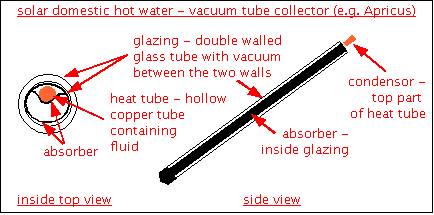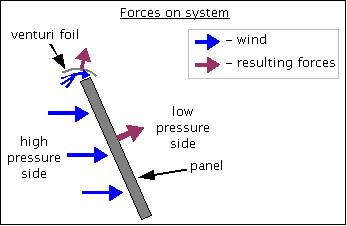Clearing snow off panels using the wind/venturi effect
This is an innovative self cleaning solar panel system using the wind and the venturi effect. Being in Ottawa, Ontario, Canada, we get a lot of permanent snow for two to four months of the year. The problem here was snow build-up at the base where the panels meet the roof due to the the dead air space there. This system consisted of four solar air heating panels (SolarSheats) connected in series. However, the panels can also be photovoltaic panels or solar hot water flat plate or vacuum tube collectors. This system was designed and installed by Isolara Energy Services.

The venturi effect is where air flows through a tube and the tube narrows. As the tube narrows, the air pressure decreases and the air accelerates, the goal here being to get faster moving air blowing over the panels to clean off any snow, or in this example, to blow away snow that was building up at the base of the panels where they meet the roof. It doesn't always have to be a tube though. In this case the air flows between the roof and curved length of sheet metal.
For this location there is a large river on the north side, the Ottawa river. Even though in the winter it is frozen solid, there is still a nice breeze from it for the intake of the venturi "tube".
Heat removal and results
You might think that the fast moving air flowing over the front of the solar air heater panel would suck the heat away from the glazing (glass front) of the panel, and of course it does, just as any wind would. However, the part of the panel that is heated by the sun is the dark colored absorber which is separated from the outside by the glazing and an air gap, both of which act as insulators. Since the addition of this venturi system, the customer reports no snow build-up at the base of the panels while still getting plenty of heat.
Other types of solar panels that would benifit
Photovoltaic panels (solar electric/power)
A photovoltaic panel (solar electricity generating panel) decreases in efficiency the hotter the panel. In this case the glazing is glued directly to the solar energy collecting material (e.g. silicon solar cells) with no air gap and so would benefit from any removal of heat by the air flow.
The photo above and those below are from installations by Ottawa Solar Power.
SDHW - vacuum tubes
Solar domestic hot water (solar thermal) systems using vacuum tubes can especially benefit greatly from this technique since the outside of the tubes remain cold due to the vacuum between the glazing and the absorber. This is a major problem in a snowy climate since the snow will not get any heat from the hot absorber and snow will not melt off them. Instead snow and freezing rain will happily pile up as on any other cold surface. This happens with tubes that are not mounted on a sufficiently steep angle and are mounted close to the roof.

SDHW - flat plate collectors
Solar domestic hot water systems (solar thermal) using flat plate collectors are much like the solar air heating panels above in that there is glazing and an air gap in front of the absorber to act as insulators, the majority of the heat being at the absorber. So air flowing over the glazing will pull heat from the glazing but not affect the absorber much due to the insulation value of the air gap and the glazing.

However, these flat plate collectors are typically mounted on a steep enough angle that snow will fall off naturally. The only concern would be a location where snow that does fall off has no where to go and instead builds-up at the base of the panel, eventually beginning to cover it from the bottom up, as was the case with the solar air heater system it was designed for above. Notice in both photos below that the angle is steep and in the second photo, there is ample room for snow that does fall off to pile up without blocking the panel.
Panels as wings or sails
We often refer to solar panels as wings or sails in that if wind gets behind them a large enough force can be produced to break the panel away from the roof or the frame that the panel is mounted to or even to knock over a system of panels mounted on a pole. With the addition of this venturi system the forces are even greater as metal foil is acting like a wing, redirecting the wind downward creating lift. As with any system, this extra amount of force must be taken into account. Wind gusts of 100 kilometers per hour will become more prevalent in the Ottawa area as climate change progresses and we are already starting to see this happen.

